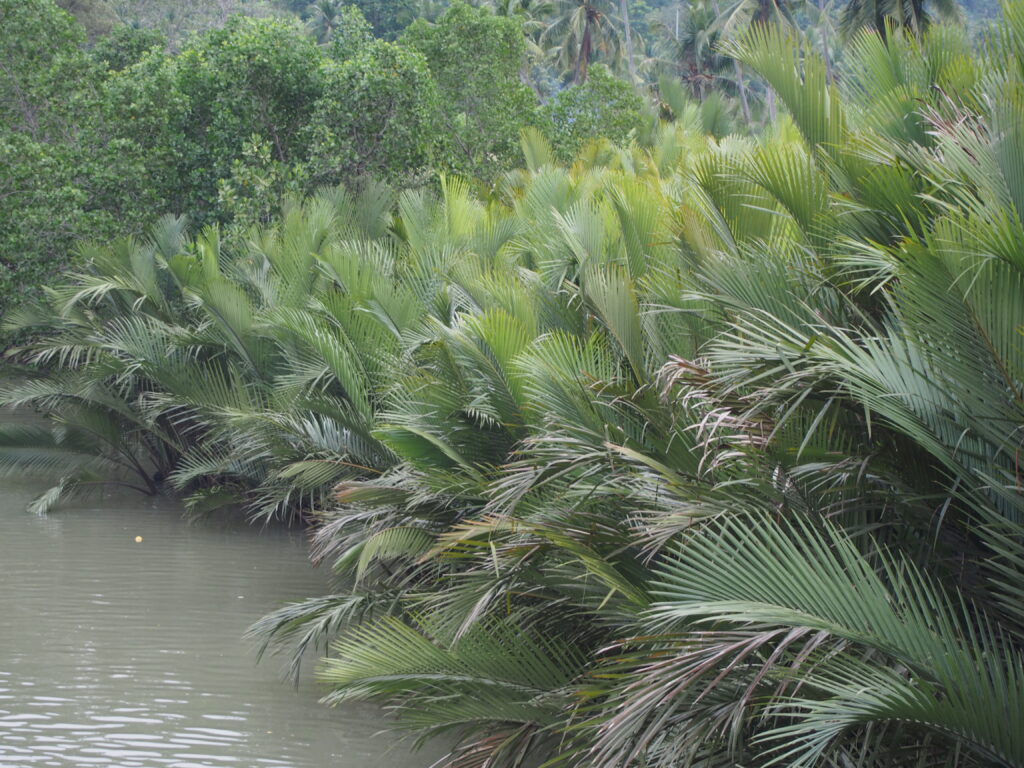By Henrylito D. Tacio
Photos courtesy of Robert Finlayson
According to the World Agroforestry Philippines, a kind of palm that grows along the coastlines and estuarine habitats can be one possible solution to the problem of the food crisis that the country will soon be facing.
“For hundreds of years, indigenous populations in the Philippines and Indonesia have been tapping the sweet, sugary sap of palm trees and feeding them to animals as their primary energy source,” said Dr. Craig Jamieson, a researcher with the agroforestry center.
According to him, when Portuguese navigator Ferdinand Magellan came to the Philippines in the 16th century, he found local people already tapping palm trees, whose leaves were used as a roofing material for bahay kubo.
In his book, “Voyages,” Captain James Cook observed how hogs were fattened up with sugar palm syrup and rice husks in Savu, Indonesia, in 1770. The syrup was also used to fatten dogs and fowls.
In short, nipa palm can be tapped as a source of feed for livestock. “Two-thirds of the world’s agricultural land is actually used for feeding livestock rather than humans directly,” Jamieson said.
In the Philippines, for instance, about 30% of its arable land is used for growing corn to feed livestock. Yet, there is “a much more efficient way of producing animal feed,” he pointed out.

Jamieson said that tapping nipa palm has been used for centuries in Southeast Asia and supported a great number of livestock and even people “even with few resources.”
“Despite its potential for being a major solution for food insecurity, this traditional technology has been largely neglected and almost forgotten by farmers, agricultural scientists and policy makers,” he lamented.
Using nipa palm as feed for livestock is not only viable but also economically feasible. “In the modern era, scientific studies have backed up the effectiveness of this practice, showing the palm sap to be the livestock equivalent of rocket fuel,” Jamieson said.
He cited a study conducted in Cambodia: “Pigs fed daily with 7–8 kilograms of palm syrup had an average growth rate of 250–550 g per day over five months. This lean gain is much higher than the 60 g/day average growth rate of pigs fed with conventional feeds.”
The study showed that to produce 7–8 kilograms of palm syrup requires tapping one-to-two palm trees per day.
“Aside from increased daily lean gain, using nipa sap for producing palm juice to feed pigs gave farmers 14 times higher economic returns per tree than using it for producing sugar syrup,” Jamieson reported.
The productivity of palms is truly extraordinary, he said. “Unlike annual crops, they are able to photosynthesise 365 days a year, converting sunlight to sugar that can be directly extracted and used,” he explained.
Applying basic physics, “it’s a fundamentally more efficient process than most of today’s food production.” In addition, it “enables much higher yields: typically, four times the calorific yield per hectare compared with annuals like corn.”
Jamieson observed that the common annual crops had been the focus of agricultural science and technology development over the last century. In comparison, nipa palm tapping remains a cottage industry until today.
“The main problem is the labor costs because harvesting requires climbing a tall tree twice a day to extract the sap from severed flowering shoots in the canopy,” he said.
To overcome this problem, some of the leading scientists in the Philippines – including Dr. Rodel Lasco and Dr. Eufemio Rasco – have focused on a low-growing tree that can be tapped for sugar without the need for climbing.
The nipa palm, known in the science world as “Nypa fruticans,” is one of the crops that thrive well in the mangrove ecosystem. One author gives this information: “Nipa palm grows in soft mud and slow moving tidal and river waters that bring in nutrients. The palm can be found as far inland as the tide can deposit the floating nuts.”
This kind of palm has a horizontal trunk that grows beneath the ground, and only the leaves and flower stalk grow upwards above the surface. “Its flowering shoots are produced at waist height, making tapping much quicker and easier,” Jamieson said.
As the nipa palm grows in brackish water, it does not require precious freshwater for its production. As such, nipa palm “saves both land and water, the two critical resource issues facing world food security,” Jamieson said.
In the Philippines, pork is the most popular meat. “It has been shown that both pigs and ducks can thrive on a liquid sugar diet,” Jamieson contends. “If, in addition to this, the animals’ manure is used to make clean biogas for cooking, the whole system could go a long way towards meeting food and energy needs together” not only in the Philippines but throughout Southeast Asia, where nipa palms grow profusely.
The sap from sugar palms can be used to produce biofuel, Dr. Jamieson said.
“The amount of potential ethanol produced from nipa (at 12000 liters per hectare) is twice that produced from sugar cane, which only has 6000 liters per hectare,” he said. “Five to seven times more fuel could be produced from the sap than from the oil of coconut palms.”

